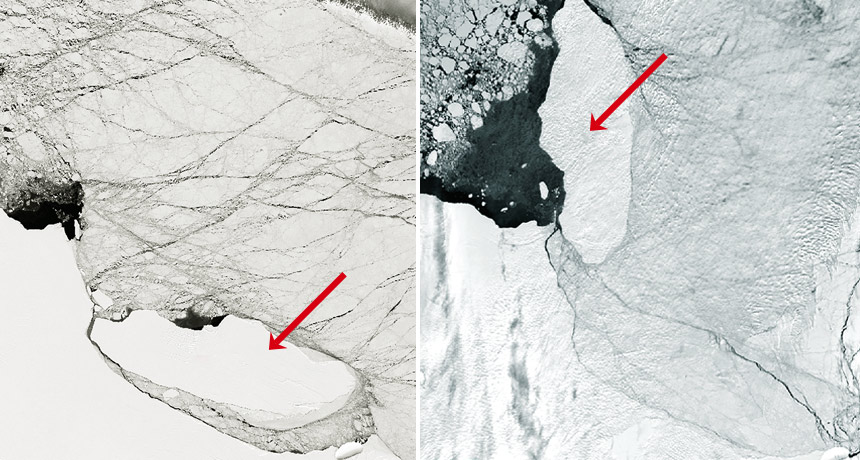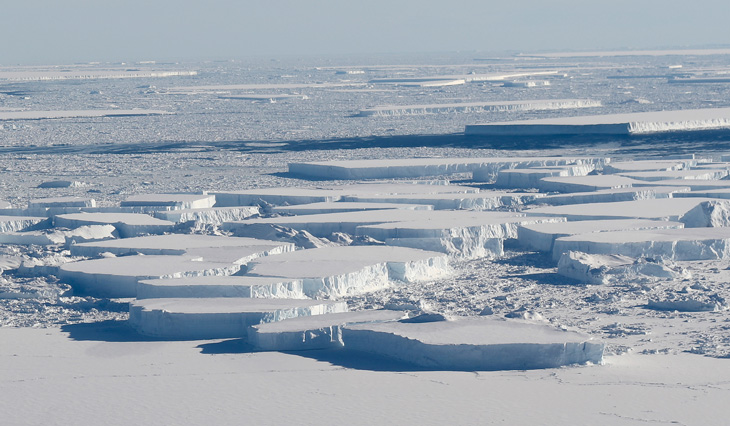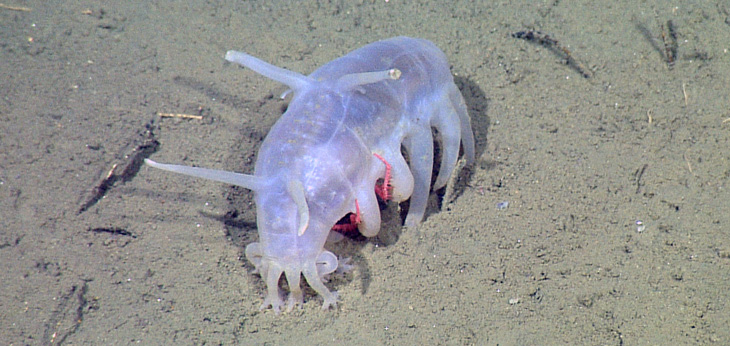An Antarctic expedition will search for what lived under the Larsen C ice shelf
A year and a half after a giant iceberg calved, scientists aim to collect seafloor creatures

BERG IN MOTION Iceberg A68 fully split from the Antarctic Peninsula’s Larsen C ice shelf in July 2017, but was still hugging the coast in November 2017 (left). A year later, the iceberg had rotated around and drifted northward, fully exposing the seafloor it once shadowed (right).
ESA
- More than 2 years ago
Maybe the fourth time’s the charm. On February 9, an international team of scientists is embarking on yet another mission to hunt for ocean life that may have once dwelled in the shadow of a giant iceberg (SN Online: 10/13/17). The scientists, led by researchers at the Alfred Wegener Institute in Bremerhaven, Germany, are headed to the Larsen C ice shelf on the Antarctic Peninsula, where a Delaware-sized iceberg broke off a year and a half ago.
Three previous expeditions have set a course for the ice shelf since the big break in July 2017 (SN: 8/5/17, p. 6). To reach the site, ships must navigate through sea ice drifting in the Weddell Sea, which lies between the Antarctic Peninsula and the main continent. There’s a narrow time window when the sea ice is at its sparsest: just after the Southern Hemisphere’s midsummer, from February into March.
But good timing isn’t a guarantee of success. Two previous missions, a British Antarctic Survey–led expedition in February 2018 and a Korea Polar Research Institute mission in March 2018, were stymied by thick sea ice blocking their way through the Weddell Sea (SN Online: 3/3/18). A third, led by scientists at the Scott Polar Research Institute in Cambridge, England, reached the shelf in late January 2019, but strong winds and dangerous ice floes ultimately forced the team to move on to focus on its primary (and still ongoing) mission — to find polar explorer Ernest Shackleton’s ship Endurance, which sank in the Weddell Sea in 1915.
This latest team will be traveling aboard the Alfred Wegener Institute’s icebreaker Polarstern, the most powerful ship yet to make the attempt. Polarstern’s reinforced hull means that the ship can withstand greater battering from sea ice, and can linger longer in the area until the waters begin to freeze — roughly at the end of March.

Moreover, the berg that broke off from Larsen C, now dubbed A68, also has finally moved out of the way, fully exposing the seafloor that it once shadowed. That also reduces the risks: With the iceberg still looming nearby, last year’s expeditions were in danger of being crushed by it, or rocked by large waves generated by falling ice chunks.
“I’m confident that if anyone’s going to get there, it’ll be this mission,” says Huw Griffiths, a marine biologist with the British Antarctic Survey in Cambridge, England, who will lead the marine biology portion of the expedition.
Science News talked with Griffiths about what he hopes to find lurking on the seafloor. His responses have been edited for length and clarity.
SN: What sorts of equipment will you use to study the seafloor?
Griffiths: Sonar to study the seafloor shape, and … a towed camera system so we can see the bottom of the sea. That’s so we can know what to deploy and where to deploy it — to avoid boulders, for example. Basically, it’s to minimize damage to the seafloor or the equipment. And later, we can study the images to count animals per square meter on the seafloor.
SN: How will you collect samples of seafloor life?
Griffiths: We’re deploying two types of net: an epibenthic sled, which is like two nets on a large metal sled [that] slides along the seafloor and dislodges animals that go into the nets; and an Agassiz trawl, which is a metal-framed fishing net that drags along the seafloor.
We also want to understand the physical environment — having the background geology, oceanography and chemistry help us to understand why we’re finding what we find.
SN: What sorts of things do you need to collect to understand that environment?
Griffiths: Water samples for temperature, salinity and dissolved gases, of course. Geochemistry on sediment samples, to see what sort of food content they might contain. We also want to know the sizes of sediment grains on the seafloor. Some animals are dependent on mud versus sand versus gravel. Animals that filter feed, like sponges, could be clogged up by too much fine sediment.
SN: In an under-ice environment, what sort of food was even available?
Griffiths: There were hundreds of meters of ice blocking the light, so there were no phytoplankton blooms in the water, which also means no zooplankton feeding on them. Since no food is raining down through the water, animals that don’t move but just sit on the seafloor may have to wait for food to be swept in sideways via currents. So the area that was under the iceberg and right next to the glacier isn’t completely cut off from food sources in the ocean, but the food getting there may not arrive very quickly. And where you’re sitting in the currents determines how much food you get. Those animals would have to be able to survive decades without any food, maybe.
SN: That sounds bleak.
Griffiths: There may also be some that can get up and move around, like sea pigs. They look like fat little piggies but are actually invertebrates, mobile sea cucumbers that can go around hoovering up the sediment for food. That kind of animal could probably do quite well. Things that don’t move much, like sponges or corals or sea anemones, would have to be able to cope with low or sporadic food inputs.

SN: Do you expect to find any other potential life-forms?
Griffiths: We know methane can seep from under these ice shelves, and there’s an ecosystem of animals that could be associated with those. There’s some evidence at Larsen A and B that there might have been such [chemosynthetic] environments before the icebergs broke off, but no one ever saw them alive. We saw shells of clams usually found in these environments. But once the shelf moves out of the way, the methane in the water escapes and becomes too diluted [to support that ecosystem].
SN: It’s been about a year and a half now since the Larsen C iceberg broke off. Are you worried that the ecosystem that was under the ice has already dramatically changed?
Griffiths: [No, because] for the first six months to almost a year, this iceberg didn’t move that much. Essentially it sat there, with just a small crack between it and the ice shelf. It wasn’t until a few months ago that it was really moving away. But that whole area it sat over is now completely clear, so we can [start to] expect some differences.
SN: How will you be able to tell potential interlopers from the original residents?
Griffiths: There’s probably already a difference in the plankton, but in terms of the larger animals on the seafloor and especially the crawlers or those that develop in place from larvae, it should be easy to distinguish which ones are juveniles and newcomers. A lot of these Antarctic animals can take 50 to 100 years to grow. Some sponges can be as much as 1,000 years old.
SN: So what do you think is down there?
Griffiths: Until we actually get there, it’s really a best guess. All we know about this environment is from a handful of drill holes through an ice shelf. It’s a whole environment we know nothing about. There are these tantalizing shots of something living there. That’s why we need to jump on opportunities like this.






